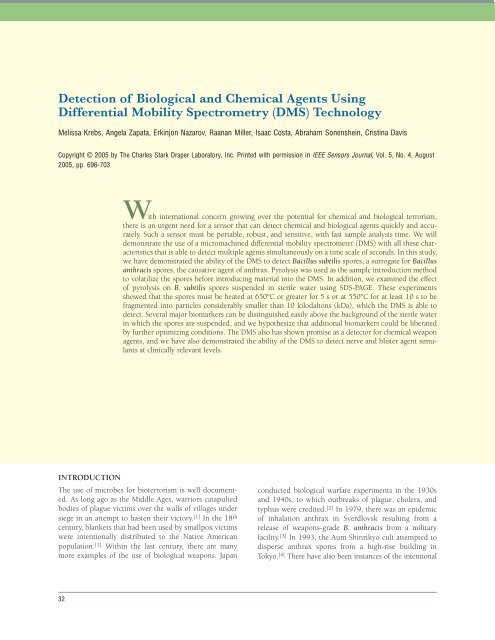TECHNOLOGY DIGEST - Draper Laboratory
TECHNOLOGY DIGEST - Draper Laboratory
TECHNOLOGY DIGEST - Draper Laboratory
Create successful ePaper yourself
Turn your PDF publications into a flip-book with our unique Google optimized e-Paper software.
Detection of Biological and Chemical Agents Using<br />
Differential Mobility Spectrometry (DMS) Technology<br />
Melissa Krebs, Angela Zapata, Erkinjon Nazarov, Raanan Miller, Isaac Costa, Abraham Sonenshein, Cristina Davis<br />
Copyright © 2005 by The Charles Stark <strong>Draper</strong> <strong>Laboratory</strong>, Inc. Printed with permission in IEEE Sensors Journal, Vol. 5, No. 4, August<br />
2005, pp. 696-703<br />
INTRODUCTION<br />
With international concern growing over the potential for chemical and biological terrorism,<br />
there is an urgent need for a sensor that can detect chemical and biological agents quickly and accurately.<br />
Such a sensor must be portable, robust, and sensitive, with fast sample analysis time. We will<br />
demonstrate the use of a micromachined differential mobility spectrometer (DMS) with all these characteristics<br />
that is able to detect multiple agents simultaneously on a time scale of seconds. In this study,<br />
we have demonstrated the ability of the DMS to detect Bacillus subtilis spores, a surrogate for Bacillus<br />
anthracis spores, the causative agent of anthrax. Pyrolysis was used as the sample introduction method<br />
to volatilize the spores before introducing material into the DMS. In addition, we examined the effect<br />
of pyrolysis on B. subtilis spores suspended in sterile water using SDS-PAGE. These experiments<br />
showed that the spores must be heated at 650°C or greater for 5 s or at 550°C for at least 10 s to be<br />
fragmented into particles considerably smaller than 10 kilodaltons (kDa), which the DMS is able to<br />
detect. Several major biomarkers can be distinguished easily above the background of the sterile water<br />
in which the spores are suspended, and we hypothesize that additional biomarkers could be liberated<br />
by further optimizing conditions. The DMS also has shown promise as a detector for chemical weapon<br />
agents, and we have also demonstrated the ability of the DMS to detect nerve and blister agent simulants<br />
at clinically relevant levels.<br />
The use of microbes for bioterrorism is well documented.<br />
As long ago as the Middle Ages, warriors catapulted<br />
bodies of plague victims over the walls of villages under<br />
siege in an attempt to hasten their victory. [1] In the 18 th<br />
century, blankets that had been used by smallpox victims<br />
were intentionally distributed to the Native American<br />
population. [1] Within the last century, there are many<br />
more examples of the use of biological weapons. Japan<br />
32<br />
conducted biological warfare experiments in the 1930s<br />
and 1940s, to which outbreaks of plague, cholera, and<br />
typhus were credited. [2] In 1979, there was an epidemic<br />
of inhalation anthrax in Sverdlovsk resulting from a<br />
release of weapons-grade B. anthracis from a military<br />
facility. [3] In 1993, the Aum Shinrikyo cult attempted to<br />
disperse anthrax spores from a high-rise building in<br />
Tokyo. [4] There have also been instances of the intentional

















